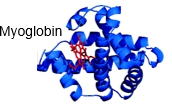In this video, we're going to learn how to approximate the mass of a protein. Each amino acid actually has a unique mass, except for just two amino acids, and those two exceptions are leucine and isoleucine. That's because they are isomers of one another, so they have the same exact chemical formula and the same exact mass. Most proteins in nature are quite large, ranging from having several hundred amino acids up to several thousands of amino acids. Calculating the exact mass of a protein with so many amino acids can be a pretty cumbersome and long-drawn-out process, especially if we need to take into account the unique masses of the amino acids. Because it is such a cumbersome process, we approximate the mass of a protein. Luckily, the mass of a protein can be easily approximated with only the total number of amino acid residues.
When it comes to approximating the mass of a protein, we need to consider two different factors. The first is the average molecular weight of the 20 free alpha amino acids, which is 128 grams per mole. Molecular weight can be abbreviated with MW or MR for relative molecular weight, which is the same value as the molecular weight, and we're going to treat them as being the same. The key to this first point here is actually the word 'free'. Recall that free amino acids are separate and independent from one another and are not linked via peptide bonds. This is the molecular weight of the free amino acids.
With the second point here, we need to recall that a water molecule, an H2O molecule, is lost with the formation of each peptide bond via a dehydration synthesis reaction to link an amino acid. That means that we need to consider the molecular weight of a water molecule, which is 18 grams per mole. Essentially, this makes the average molecular weight of an amino acid residue to be 110 grams per mole. We get this number by taking the difference between the average molecular weight of the free amino acids (128 grams per mole) minus the molecular weight of a water molecule (18 grams per mole) that is lost with the formation of each peptide bond, so 128 minus 18 gives us 110.
Below, we have an equation for the approximate mass of a protein, which is equal to the total number of amino acid residues times the average molecular weight of each amino acid residue, which is 110 grams per mole. In our example, we are asked to determine the approximate molecular weight of a protein containing 200 amino acids. We know that the molecular weight is going to be equal to the total number of amino acids, which is given to us as 200, multiplied by the average molecular weight of an amino acid residue, which is 110 grams per mole. If you type this into your calculator, 200 times 110, you'll get an answer of 22,000 grams per mole, which is, of course, equivalent to answer option C here, so we can indicate that C here is correct. This concludes our lesson on approximating the mass of a protein, and we'll be able to get some practice in our next couple of videos. I'll see you guys there.



